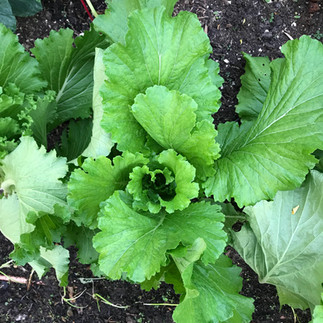Garden planning with freeze proof plants
- suma644
- Feb 5, 2024
- 7 min read
If you live in Houston and you are a gardener, you are familiar with this yucky feeling – freeze again?? So how do we freeze proof our garden planning?
As gardeners we get ourselves into meticulous garden planning, working hard at making our gardens our havens, our go to calming spots, and our backyard farmers markets.
When freeze hits in a supposedly warm cities like Houston, our delicate plants (which have not tasted freezes before) succumb to the harsh temperatures. This puts us in a bleak mood for the next two months, until the Spring fever kicks in, but on the other hand, we may just give up gardening☹
My husband and I moved to Houston from Pennsylvania about 13 years ago – one of the main reasons being to give an outlet to my year-round gardening zeal. In Zones 5 and 6 where I spent couple of decades, gardening started on Memorial Day and ended on Labor Day or earlier. The gardening window was so short, which made me fill my house with house plants.
Then we moved to Houston, I was ecstatic with the thought of gardening year-round. I had a learning curve, moving from cold hardy gardening to heat tolerant gardens. So like everything else I do, I did a deep dive and became a master gardener (a program run by Texas A&M Agri-life extension) and went on to become certified as a garden designer. This gave me the right tools to pick the right plants (it did take some trial and error) and come up with a garden that can sustain and thrive in extreme temperatures.
First let us put things in perspective. When do plants get impacted? In a hard freeze. What’s a hard freeze? Hard freeze is when temperatures fall below 24° for two hours or more. As per Houston Chronicle, we dropped to 21° in January of 2014 and 2017, 19° in January of 2018. Then the mega freeze Uri of February 2021 and arctic freeze of December 2022 at 7°. Below you can see pictures from my garden during these freezes.
Coming from regions which have subzero temperatures for almost 4-6 months, why am I so disheartened with these freezes? Because I did not want to see one more shivering day here in Houston. The first few winters were as I expected – moderate to mild. I threw caution to winds and added some sub-tropical plants to my garden. And then the first freeze of 2014 shocked me to the core – I was so depressed. Then the one in 2017 – I consoled myself with my inner knowledge that plants may look dead, but they will come back. Back in East Coast, we are totally prepared to see brown and dead plants and trees for months together, and then the magic happens in late April or May – new shoots appear. It is a thrilling sight.
I talked myself into this reality and the excitement of seeing new growth once the freeze recovery begins. And it worked😊 However, I learnt to keep adding freeze proof plants to my garden and now I am not so worried or put off.
Now, coming to the main topic of this blog – how to plan our gardens with freeze proof plants? I am going to share all my experiences, trials, and errors so you can benefit from it.
It may sound too optimistic or unreal but this is the right time to plan your 2024 gardens. Hear my thoughts here:
So now let's dig into what works and what doesn't.
Plants that work against the freezes and low temperatures:
I will categorize the plants into 3 main groups
Evergreen – Plants that do not miss a beat in varying temperatures and stay green
Root hardy – Plants that die back to the ground but revive when warm temperatures resume
Self-seeding – Plants that totally die but would have dropped their seeds the previous year, thereby creating new plants in the following year.
Evergreen - Ideally, we all would like to have several evergreen plants in our gardens so we can see the color green and not just brown everywhere. In the list below, if you see lower numbers for zones, it indicates how cold hardy it can be. So which evergreen plants made it out alive and kicking in the last few freezes?

Golden Euonymus – a very underutilized shrub. Can be used as foundation planting, as a hedge, lining a walkway or tucked in between plants.
The leaves are variegated with green and yellow creating visual appeal
Very tough, easy to care for, and tolerates poor soils – zones 6-9
Takes well to pruning if we want to shape it
Thrives in full sun as well as part sun
Not a fast grower; if we let it, it may reach 3’x6’

Sunshine Ligustrum – about 7 years ago, I first came across this plant and wanted to use it for my landscape designs. But since it was just then introduced by Southern Living, it was not widely available. I did use it much since then – and so did the builders and contractors. This plant stayed tough through our freezes and heat.
Very cold and heat tolerant – zones 6-10
Vibrant golden foliage
Great for hedges, walkways, and foundation plantings
May get woody in super heat but responds well to pruning
May reach 3-4 x 5-6 feet

Liriope – Used extensively by builders and garden designers. I used to not like it much but I discovered the value of it – staying green through the freezes. These grass-like plants add volume where you need it and can be used in several creative ways. Lilyturf is the common name.
Tough ground cover; can be showy – zones 4-10
Its deep green can create a contrast to add landscape interest
A great plant to edge a walkway or the front of the flower bed
Thrives in degrees of shade; can tolerate filtered sun; so ideal to plant under oak trees
Clumping habit, can divide every few years

Carex or Sedge – one of my favorite plants/grasses. Again, very underutilized in my opinion. Creates a beautiful flowing character and is great both in flower beds and in containers.
Very resilient and versatile – zones 5-9
Bright lime green or variegated leaves
Excellent resistance to deer if that is a problem for some of you
Can be used as a specimen plant, in containers or mixed flower beds

Holly Fern – one tough cookie for the shade gardens. Its glossy leaves add interest to drab areas
Evergreen in zones 6-10
Great to add to shaded areas or under oak trees
Can also be used in mixed containers

Camellias – a must have for Southern gardens. These are evergreen and bloom from Winter to early Spring. The plant itself has nothing to worry from freeze but you may want to protect the buds, so they do not shrivel up
Redbor Kale – this is a great versatile plant, both edible and ornamental. It did great in the freeze. Adds a great contrast to green foliage
Marjoram – not only a great herb but also has many more medicinal uses. Stayed green through the freeze without any additional covering
Shasta Daisy – Beautiful addition to the garden. Vibrant white flowers with a long blooming period from Spring to Summer. It clumps and spreads, making it a great plant to be divided and spread to other places in the garden or share with friends.
Rain lilies – great to add to borders in flower beds. They spring into bloom after rains, hence the name. Comes in pink, yellow, and white colors. This plant also spreads over a period of time
Pineapple guava – There are both edible and non-edible varieties. Both are ever green, but I prefer the edible variety. The plant is hardy, can be used as a hedge, and gives out pineapple flavor guavas in the Fall
Winter veggies – my cabbages, broccoli, Bok Choi, Kol Rabi, Brussel sprouts, and red veined sorrel remained green and vibrant through the freeze.
Herbs - Cilantro and mint thrived in the freeze without being covered. Rosemary, dill, sage, lemon balm, parsley, oregano and thyme remained vibrant with light covering.
Root hardy – These are the plants that seem to die to the ground but will come back within a few weeks or months. This is an extensive list and so is very encouraging. This means that if you plan well, you will see the empty spaces in your garden after the freeze, just for a few weeks or a couple months. This also means that you invest once in these tough plants, and you will be rewarded for many years. And here is the list:
Thryallis – A nice shrub or small tree. Amazingly fast grower with dainty yellow flowers
Hemelia – A nice big shrub that attracts humming birds. It has a Fall foliage as well
Ligularia – Very attractive glossy green leaves and winter blooms. Does great in part Sun
Hostas - these plants are so versatile for the shade garden. They come in hues of green and are fine in deep cold but not in hot sun.
Althea – One of the first plants to dress up in new leaves after the freeze. Has beautiful hibiscus flowers and a terrific addition to the flower garden
Hardy hibiscus – several varieties including Moy Grande, Red Flare, Texas Star, Turks Cap etc.
Salvias – many, many varieties. Also come back quickly after freeze, spread and multiply so you can move them around in your garden. Many colors and heights to choose from
Duranta – a small tree with multi season interest. Nice panicles of purple flowers in summer and golden berries in the fall
Roses – many roses to choose from, especially the Earth-Kind™ roses which will do very well in our region
Angel wing jasmine – a sprawling shrub with starry flowers that are slightly fragrant.
Vines that are root hardy - Carolina Jessamine, Confederate Jasmine, Rangoon creeper, blue sky vine, Mexican flame vine, Mexican butterfly vine, cross vine, honey suckle, Texas evergreen wisteria, climbing roses etc.
Plants that self-seed – Larkspur, vincas, violas, snapdragons, dianthus, gomphrena, zinnias etc.
There you have it. These lists are not comprehensive by any means – they are mostly based on my personal experience with my garden. But I can confidently say that we do not need to replace the plants each year; that we can feel a little less depressed about this whole freeze thing and that there is hope for vibrant gardening.
To make the process of making your garden thrive in spite of weather fluctuations easy for you, you can fill out the consultation form below and I will be happy to work with you.
































Comments